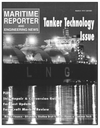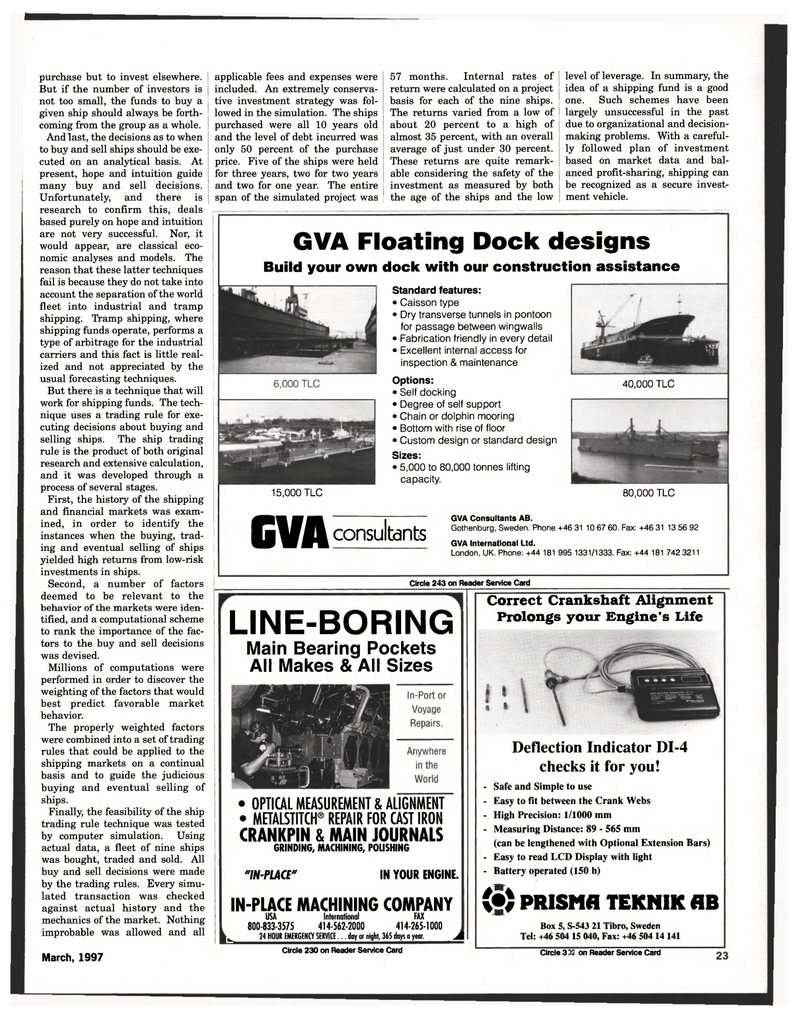
Page 23: of Maritime Reporter Magazine (March 1997)
Read this page in Pdf, Flash or Html5 edition of March 1997 Maritime Reporter Magazine
purchase but to invest elsewhere.
But if the number of investors is not too small, the funds to buy a given ship should always be forth- coming from the group as a whole.
And last, the decisions as to when to buy and sell ships should be exe- cuted on an analytical basis. At present, hope and intuition guide many buy and sell decisions.
Unfortunately, and there is research to confirm this, deals based purely on hope and intuition are not very successful. Nor, it would appear, are classical eco- nomic analyses and models. The reason that these latter techniques fail is because they do not take into account the separation of the world fleet into industrial and tramp shipping. Tramp shipping, where shipping funds operate, performs a type of arbitrage for the industrial carriers and this fact is little real- ized and not appreciated by the usual forecasting techniques.
But there is a technique that will work for shipping funds. The tech- nique uses a trading rule for exe- cuting decisions about buying and selling ships. The ship trading rule is the product of both original research and extensive calculation, and it was developed through a process of several stages.
First, the history of the shipping and financial markets was exam- ined, in order to identify the instances when the buying, trad- ing and eventual selling of ships yielded high returns from low-risk investments in ships.
Second, a number of factors deemed to be relevant to the behavior of the markets were iden- tified, and a computational scheme to rank the importance of the fac- tors to the buy and sell decisions was devised.
Millions of computations were performed in order to discover the weighting of the factors that would best predict favorable market behavior.
The properly weighted factors were combined into a set of trading rules that could be applied to the shipping markets on a continual basis and to guide the judicious buying and eventual selling of ships.
Finally, the feasibility of the ship trading rule technique was tested by computer simulation. Using actual data, a fleet of nine ships was bought, traded and sold. All buy and sell decisions were made by the trading rules. Every simu- lated transaction was checked against actual history and the mechanics of the market. Nothing improbable was allowed and all
March, 1997 25 applicable fees and expenses were included. An extremely conserva- tive investment strategy was fol- lowed in the simulation. The ships purchased were all 10 years old and the level of debt incurred was only 50 percent of the purchase price. Five of the ships were held for three years, two for two years and two for one year. The entire span of the simulated project was 57 months. Internal rates of return were calculated on a project basis for each of the nine ships.
The returns varied from a low of about 20 percent to a high of almost 35 percent, with an overall average of just under 30 percent.
These returns are quite remark- able considering the safety of the investment as measured by both the age of the ships and the low level of leverage. In summary, the idea of a shipping fund is a good one. Such schemes have been largely unsuccessful in the past due to organizational and decision- making problems. With a careful- ly followed plan of investment based on market data and bal- anced profit-sharing, shipping can be recognized as a secure invest- ment vehicle.
GVA Floating Dock designs
Build your own dock with our construction assistance
Standard features: • Caisson type • Dry transverse tunnels in pontoon for passage between wingwalls • Fabrication friendly in every detail • Excellent internal access for inspection & maintenance
Options: • Self docking • Degree of self support • Chain or dolphin mooring • Bottom with rise of floor • Custom design or standard design
Sizes: • 5,000 to 80,000 tonnes lifting capacity. 40,000 TLC 80,000 TLC 15,000 TLC
Qyj^ consultants
GVA Consultants AB.
Gothenburg, Sweden. Phone +46 31 10 67 60. Fax: +46 31 13 56 92
GVA International Ltd.
London, UK. Phone: +44 181 995 1331/1333. Fax: +44 181 742 3211
Deflection Indicator DI-4 checks it for you! - Safe and Simple to use - Easy to fit between the Crank Webs - High Precision: 1/1000 mm - Measuring Distance: 89 - 565 mm (can be lengthened with Optional Extension Bars) - Easy to read LCD Display with light - Battery operated (150 h) (•) PRISMA TEKNIK AB
Box 5, S-543 21 Tibro, Sweden
Tel: +46 504 15 040, Fax: +46 504 14 141
Correct Crankshaft Alignment
Prolongs your Engine's Life
Circle 243 on Reader Service Card
Circle 331 on Reader Service Card
LINE-BORING
Main Bearing Pockets
All Makes & All Sizes • OPTICAL MEASUREMENT & ALIGNMENT • METALSTITCH® REPAIR FOR CAST IRON
CRANKPIN & MAIN JOURNALS
GRINDING, MACHINING, POLISHING "IN-PLACE" IN YOUR ENGINE.
IN-PLACE MACHINING COMPANY
USA International FAX 800-833-3575 414-562-2000 414-265-1000 ^ 24 HOUR EMERGENCY SERVICE... day or nighl, 365 days a year. A
Circle 230 on Reader Service Card

 22
22

 24
24
